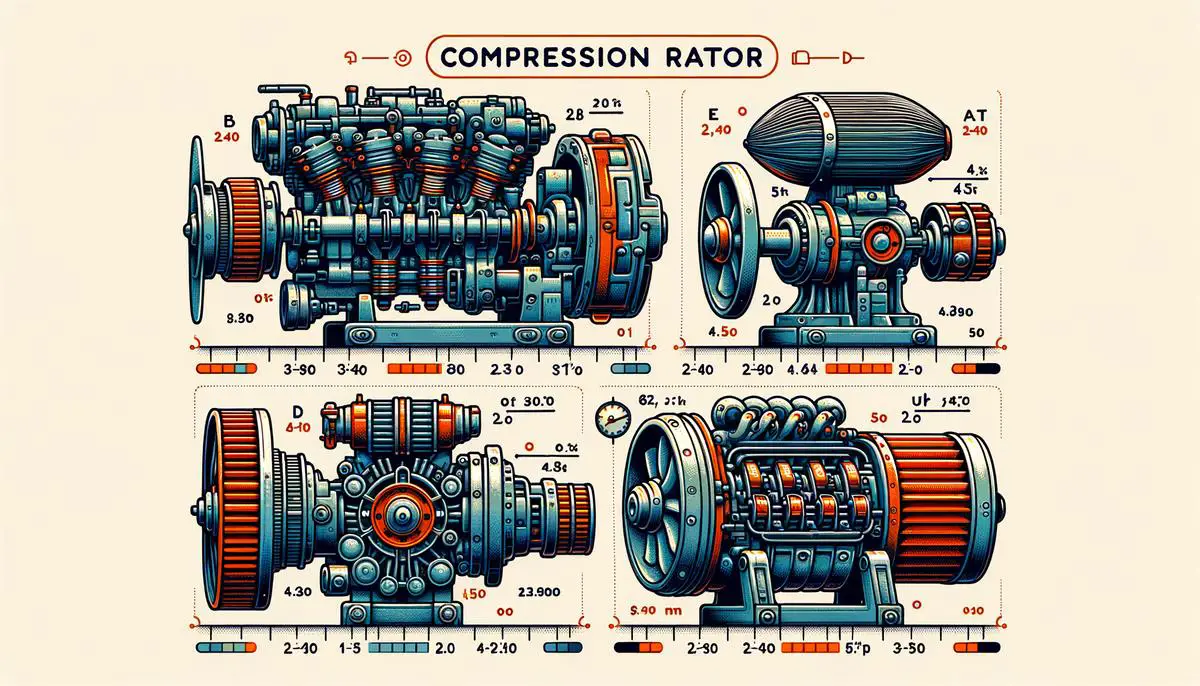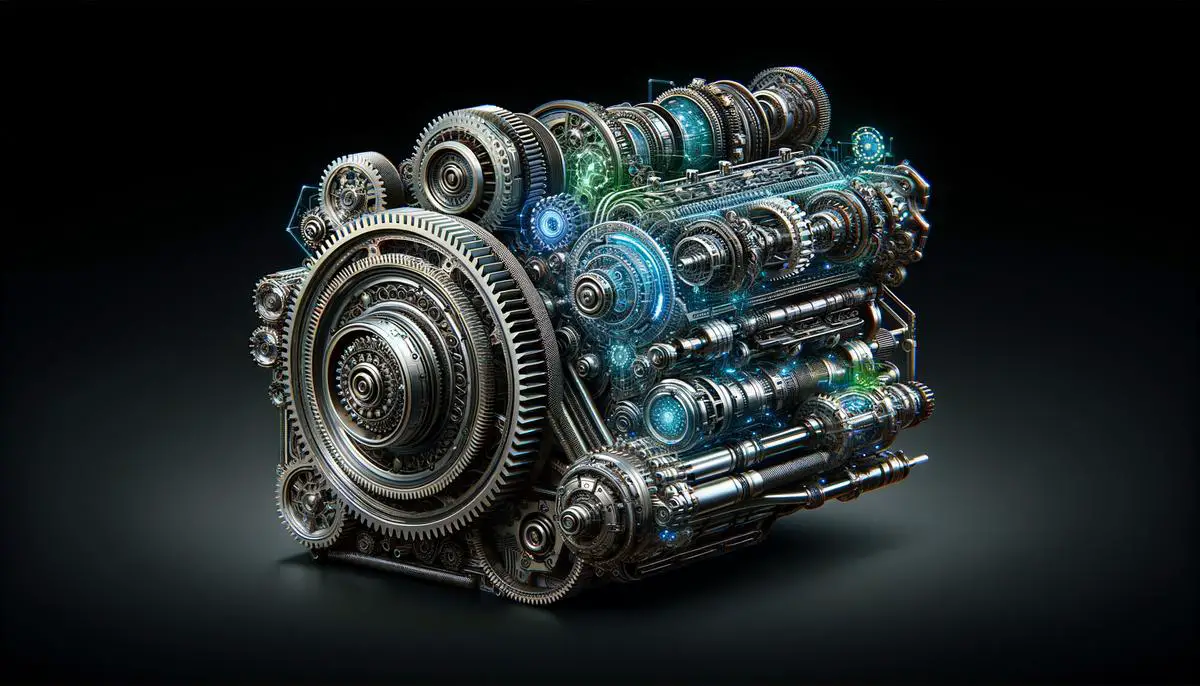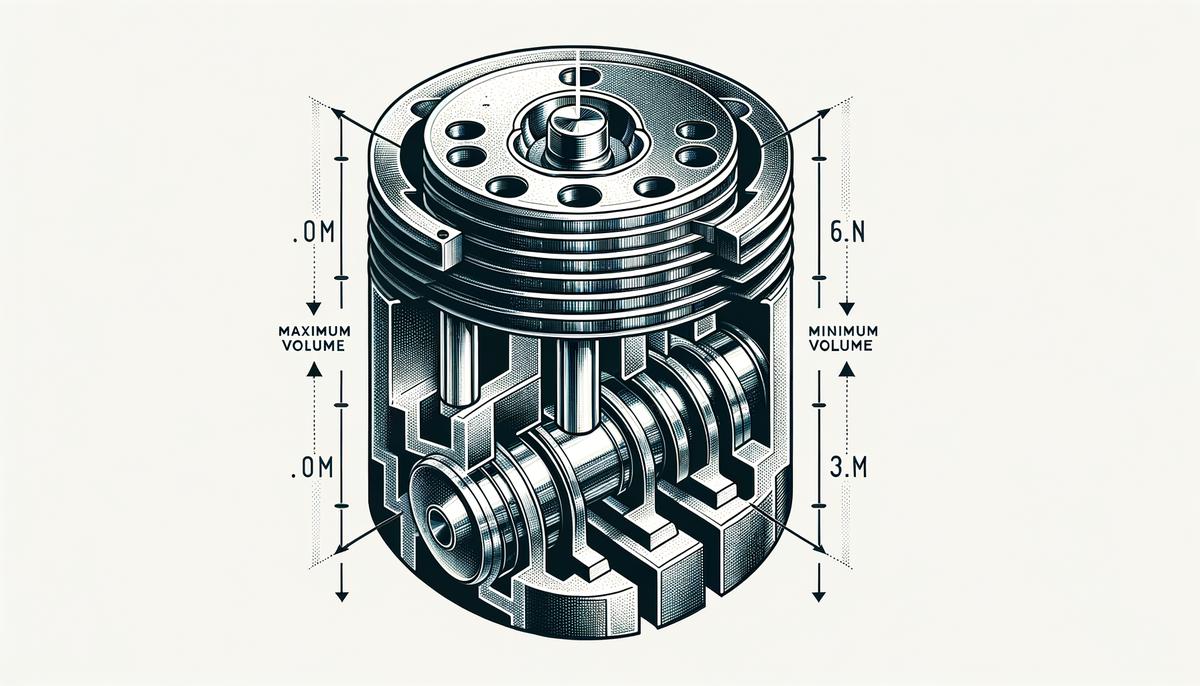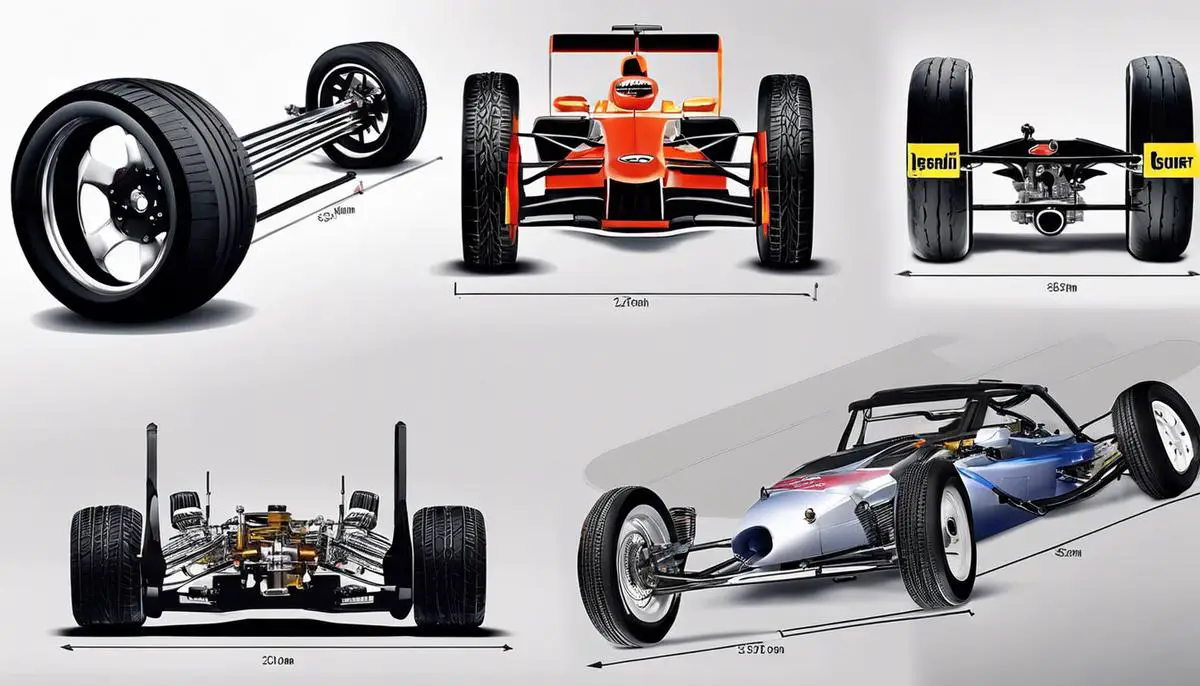Exploring the essence of what makes our vehicles tick, the topic of compression ratio stands at the forefront of understanding engine performance and efficiency. This crucial aspect of automotive engineering holds the key to unlocking power, ensuring fuel economy, and maintaining engine health. With a focus on the significance of compression ratios across various engine types, advancements in technology, and their impact on performance, this article aims to shed light on the intricate balance and considerations that go into optimizing engines for today’s and tomorrow’s vehicles.
Contents
Basics of Compression Ratio
Compression Ratio: The Heart of Engine Efficiency
When diving into the mechanics of how engines work, one term that frequently pops up is the “compression ratio.” But what exactly does this mean, and why is it crucial for your engine’s performance? In essence, the compression ratio of an engine is a key player in its power, efficiency, and overall health.
At its core, the compression ratio denotes the difference in volume from when an engine’s piston is at the bottom of its movement compared to the top. To put it simply, it’s the measure of how much the engine compresses the air-fuel mixture before igniting it with a spark. This ratio is typically presented as a numeric value, such as 10:1, indicating the air and fuel mix is compressed to one-tenth of its original volume.
Why does this matter? The compression ratio is directly linked to an engine’s performance. A higher compression ratio means the air-fuel mixture is squeezed into a smaller space, increasing the mixture’s temperature. When ignited, this highly compressed mixture burns more vigorously, releasing more energy than it would under less compression. This results in more power for your vehicle from each explosion in the engine’s cylinders.
But power isn’t the only advantage of a higher compression ratio. This increased efficiency also leads to better fuel economy, as the engine can extract more energy from the same amount of fuel. In the pursuit of greener and more cost-effective driving, optimizing the compression ratio is a focal point for engine designers.
However, there are limits. Too high of a compression ratio can lead to engine knocking, a damaging condition where the air-fuel mixture detonates prematurely due to the excessive heat and pressure. Modern engines often strike a balance, using materials and engineering designs that can handle higher pressures, alongside fuels with additives to prevent knocking.
For performance enthusiasts and everyday drivers alike, understanding the compression ratio can unveil aspects of an engine’s character – from its potential efficiency to its power output. This balance of science and engineering ensures our vehicles continue to deliver the performance we expect, all rooted in the fundamental concept of the compression ratio.

Compression Ratios Across Different Engine Types
Exploring the Diversity: Compression Ratios Across Different Engine Types
When diving into the inner workings of engines, one aspect that consistently stands out is the variation in compression ratios among different engine types. This fundamental characteristic significantly influences an engine’s efficiency, power, and overall performance. Understanding these variations helps illuminate why certain engines are favored in specific applications over others.
Petrol Engines: The Conventional Choice
Starting with petrol engines, which are the most common type in passenger vehicles, compression ratios typically range from 8:1 to 12:1. This range strikes a balance between achieving efficient fuel combustion and avoiding the risk of engine knocking. Engine knocking is a problem that occurs when fuel prematurely combusts in the cylinder, leading to potential engine damage. Higher compression ratios can improve petrol engine efficiency, but they also require higher octane fuel to prevent knocking.
Diesel Engines: High Compression Powerhouses
Moving onto diesel engines, they operate at a significantly higher compression ratio, usually between 14:1 and 25:1. The absence of spark plugs in diesel engines means that air compression heats the air to such a degree that when diesel fuel is injected, it ignites automatically. The higher compression ratio of diesel engines contributes to their efficiency and the substantial torque they produce. This makes diesel engines particularly suited for heavy-duty vehicles that require significant pulling power.
Turbocharged Engines: Boosting Performance
A game-changing development in engine technology is the turbocharger. Turbochargers allow for an increase in an engine’s effective compression ratio without physically altering the engine’s compression ratio. By forcing more air into the combustion chamber, turbocharged engines can use more fuel, thus increasing power output. This technology enables smaller engines to produce more power, mirroring the performance of larger engines without a significant penalty on fuel efficiency.
Rotary Engines: A Unique Approach
Rotary engines, also known as Wankel engines, offer a different perspective on compression ratios, typically ranging between 8:1 and 10:1. These engines have a unique design that replaces the conventional piston movement with a rotary motion, providing a compact and lightweight engine. However, rotary engines have not been as widely adopted as their piston counterparts due to challenges with fuel efficiency and emissions.
Hybrid Engines: Best of Both Worlds
Hybrid engines combine the features of internal combustion engines with electric motors, allowing them to optimize performance and efficiency dynamically. The compression ratios in the combustion engine part of hybrids can vary widely depending on the manufacturer’s design goals. These engines benefit from the instant torque provided by electric motors, somewhat lessening the reliance on high compression ratios for performance.
Conclusion: A Spectrum of Engineering Choices
In the vast landscape of engine designs, the compression ratio stands out as a pivotal factor that engineers must consider. From the reliable performance of petrol engines to the robust power of diesels, and the innovative designs of turbocharged and rotary engines, to the futuristic approach of hybrids, the choice of compression ratio reflects a balance between efficiency, performance, and application demands. Each engine type, with its specific range of compression ratios, highlights the diversity of engineering solutions aimed at achieving the most effective propulsion methods for our vehicles.

Impacts of Compression Ratio on Performance
Understanding the effects of varying compression ratios on car performance dives deeply into the heart of automotive engineering. It’s akin to exploring the pulse of what makes cars tick, thrive, and deliver those exhilarating moments on the road.
For starters, let’s delve into how varying compression ratios impact engine efficiency. In a nutshell, higher compression ratios generally mean that the engine can extract more mechanical energy from a given mass of air-fuel mixture. This is because a higher compression ratio increases the thermal efficiency of the engine. The fuel burns hotter and more completely, propelling the car forward more powerfully. However, it’s crucial to note that there’s a ceiling to this benefit. Too high a compression ratio can lead to engine knocking, a condition where the fuel-air mixture combusts prematurely, potentially damaging the engine.
Now, let’s consider the aspect of emissions. In today’s world, where environmental considerations are paramount, how do compression ratios play into this? Interestingly, engines with higher compression ratios tend to produce fewer emissions. This is due to the more complete combustion of the fuel-air mixture, which reduces the number of unburnt hydrocarbons leaving the exhaust. However, this is a delicate dance, as altering the compression ratio for lower emissions must not compromise the engine’s performance or fuel efficiency.
Speaking of fuel types, it’s noteworthy that not all fuels are equal when it comes to optimal compression ratios. For instance, engines designed to run on premium gasoline can typically handle higher compression ratios compared to those meant for regular gasoline. This is because premium gasoline has a higher octane rating, making it more resistant to knocking. Hence, vehicles with high-performance engines that demand higher compression ratios often require premium fuel to operate safely and efficiently.
Another layer to this intricate relationship is the role of advanced technology in managing compression ratios. Modern engines, especially those equipped with features like variable valve timing (VVT) and direct fuel injection, can adjust their compression ratios on the fly. This serves to maximize power and efficiency while minimizing emissions across various driving conditions. It’s a testament to how far automotive technology has come, allowing for real-time optimization of engine performance.
Lastly, the discussion wouldn’t be complete without touching on the impact of compression ratios on engine durability. Generally, engines with higher compression ratios are subjected to greater stresses and temperatures. This can accelerate wear and tear, necessitating more robust materials and cooling systems to ensure longevity. Manufacturers weigh these factors meticulously, ensuring that the thrill of high performance does not lead to premature engine fatigue.
In conclusion, the journey through the effects of varying compression ratios on car performance unveils a world where physics, chemistry, and engineering intersect to delight both the driver and the environment. It’s a testament to the automotive industry’s ongoing quest for that perfect balance between raw power, efficiency, and sustainability. As we continue to push the boundaries of what’s possible, understanding the foundational concepts like compression ratios remains key to appreciating the marvels rolling out of showrooms and onto the streets.

Technological Advances and Future Trends
Advances in Compression Ratio Technology: Pushing the Envelope Beyond Traditional Limits
In the realm of automotive engineering, the quest for higher efficiency and performance continually drives innovation, especially in the field of compression ratio technology. The latest advances are not just about escalating numbers but also about refining control, expanding adaptability, and enhancing the overall performance of engines in more sophisticated ways.
One of the cutting-edge developments in this area is the introduction of Variable Compression Ratio (VCR) engines. These marvels of engineering can adjust their compression ratios on the fly, in response to driving conditions, thereby optimizing performance and efficiency at any moment. For instance, when high power is not needed, the engine can operate at a higher compression ratio to improve fuel economy. Conversely, it can lower the compression ratio when more power is demanded, reducing the risk of knock and enabling the use of lower octane fuel without compromising on performance.
Another promising technology pertains to the use of advanced materials and coatings within the engine. As engines push the boundaries of compression ratios, the stresses and temperatures within the combustion chamber also increase. Advanced materials such as ceramics and new metal alloys, along with sophisticated coatings, are being developed to withstand these harsh conditions. These materials not only survive the increased pressure and heat but also help in improving the efficiency by reducing friction and wear over time.
Furthermore, computational advances are playing a pivotal role in enhancing compression ratios. Computational Fluid Dynamics (CFD) and other simulation tools allow engineers to meticulously model and optimize the combustion process, leading to engines that can safely operate at higher compression ratios than ever before. This virtual testing ground is crucial for understanding the complex interplay of factors within a running engine, enabling the precise tweaking of engine designs for optimal performance and durability.
Looking towards the future, hybrid and electric vehicle technologies are set to influence trends in compression ratio technology as well. For hybrid engines, managing compression ratios becomes a dance of balancing the benefits of efficiency and the need for power in different phases of operation, often relying on sophisticated control systems to switch modes seamlessly. On the electric frontier, while traditional compression ratios may not apply, the principles of efficiency optimization and advanced material usage find new relevance in battery performance and longevity, hinting at a broader definition of ‘compression’ in the energy context.
As automotive technologies evolve, the future of compression ratio technology appears to be one not limited by static numbers but characterized by adaptability, advanced materials, and sophisticated control systems. This evolution promises not only enhanced performance and efficiency but also a significant impact on reducing emissions, contributing to a more sustainable future in mobility. Through the continuous push for innovation, the engines of tomorrow may bear little resemblance to their predecessors, guided by the ever-evolving science of compression.

As we examine the evolving landscape of automotive engineering, it becomes evident that the role of compression ratios extends far beyond mere numbers. It’s about the continuous quest for efficiency, the pursuit of higher performance, and the commitment to sustainable mobility. The advancements in technology and the inventive approaches to engine design underscore a future where the potential of every drop of fuel is maximized, and the environmental footprint is minimized. Through the lens of compression ratio innovation, we witness the automotive industry’s dedication to pushing the boundaries of what’s possible, ensuring that vehicles remain a vital, efficient, and exciting part of our lives.



